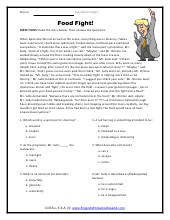It's amazing how in the Information Age students still have trouble finding and using quality references. Tried and true reference tools are slowly taking a back seat to technology. Help your students understand the value of quality reference sources.
How to Use Reference Tools to Find Answers?
Most books and essays end with an exercise with different questions and problems - answers to which are hidden in the book itself. However, it is not always necessary that the answers to such questions are located within the chapter or the book's main text. Under such circumstances, it is better to use various reference tools available online to search for answers of the questions without putting in much effort.
Books, other than novels and fiction books, are usually written with the help of various already published articles and books by senior authors in the field. The writers of the book are obliged to acknowledge and reference the works that have helped in building their knowledge of the subject to such an extent that they were able to write a book. Most of the questions to ask at the end of the book have usually their answers hidden in those references. Here are some of the reference tools that can help you find answers within minutes.
Links and Research Papers
Books always have the reference to the cited material either in the footnotes of every page or at the end. These references are usually in the form of digital links, clicking on which can take you to the relevant site. After you are on the original site, all you need to do is to put the keywords in the search bar and read the relevant lines that might have the answer to the questions asked.
Dictionaries
Most questions at the end of the books are usually about the word meanings that are in the book. Books also have a dictionary or list of difficult terms at their end and the readers can find their answers from those dictionaries and appendixes.
Readers must try to keep a pocket-sized dictionary with them all the time to make sure that they never face any difficulty with the meanings of the words wherever they are. Whenever you come across an unknown word, the best way to understand it is through looking for its meaning in a dictionary. A dictionary always provides you with the correct meaning for a word and this is why it is considered as the best reference tool to understand any word's meaning.
How to Use References to Understand Words?
While reading any text, it is common to come across some unknown or difficult words with their meaning unknown to you. In such a situation, it is advised that the reader must try to make the sense of that unknown word by looking at the context in which it is being used. However, it is not always possible to successfully find the meaning of a word by simply looking at its context.
Under such conditions, it is better to use a proper reference to understand that particular unknown word. Here are a few ways you can do that:
Use the Internet
In case you do not have a pocket dictionary with you, you can look up for the word over the web. However, this way of locating and understanding the words is not preferred by most of the language experts because the likelihood of remembering the meaning for a long time using this method is very rare.
Compare the Word's Use in Different Contexts
Sometimes, the reader remembers looking at a word somewhere but is unaware of the word's meaning. Under such a condition, the reader should compare and contrast the different contexts in which that same word is being used. Comparing different contexts of a word can also give clues to its meaning.
Fundamental Reference Tools
Reference tools are used to locate information, facts, and figures and understand the meanings. Reference tools are used widely to understand complex literary work. There are many types of reference tools but some commonly used ones are dictionary, thesaurus, and glossary. Students do know reference tools but they do not know how to use them. Discussed below is the information regarding the use of these three common reference tools:
Dictionary
There are more than a million words in the English language. One cannot learn them all. To understand and learn new words, using a dictionary is an efficient and the easiest way. Understanding how to use a dictionary is very easy. First, choose a dictionary according to your educational level. After choosing the right dictionary, read its foreword or introduction as this can help you in understanding how the words are organized in the dictionary. Since dictionaries are mostly organized in alphabetical order, try to find the section of the alphabet whose words you have to learn, use the guide words written on top of the page to find the section quickly. Go through that section to find your desired word and learn its meaning.
Thesaurus
Thesaurus contains words that are grouped according to their meanings. In other words, we can say that a thesaurus helps us to find the synonym of the word. To use a thesaurus, first select word for which you want to find the synonym, then like the dictionary, find the selected words in alphabetical arrangement. After finding the word, look at the words given on its opposite side. Out of these words, choose the best word to replace the selected word with.
Glossary
A glossary usually appears at the end of the book and is in alphabetical order. Glossary contains some unfamiliar terms along with their brief definitions. All you have to do is just to find the term and learn its definition.
